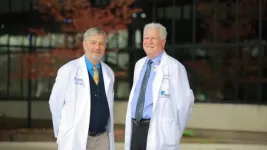(Press-News.org) The symptoms of postural orthostatic tachycardia syndrome, or POTS, can be as varied as they are confounding.
There can be fatigue, pain, bleeding disorders and anxiety. Heart palpitations and lightheadedness are common. Some patients experience gastrointestinal issues or brain fog. For the most severely affected, the simple act of standing up can send them crumpling into unconsciousness.
Though likely much more common than once thought, POTS remains something of a mystery. Many physicians have never heard of it. There's no lab test to confirm a diagnosis and no treatment to cure the condition.
That could all be changing, owed in large part to the persistence of researchers Dr. William Gunning and Dr. Blair Grubb from The University of Toledo.
"For a long time, people would question whether this disorder even existed," said Grubb, a cardiologist at The University of Toledo Medical Center and Distinguished University Professor in the UToledo College of Medicine and Life Sciences.
Grubb, who has been treating POTS patients and studying the condition for more than three decades, now believes he and his collaborators are increasingly close to proving a long-held theory that POTS is an autoimmune disorder.
He and Gunning, a professor of pathology in the UToledo College of Medicine and Life Sciences whose expertise is in platelet disorders, are collaborating on innovative research examining patients' plasma for autoantibodies and inflammatory markers.
In a retrospective study of 34 POTS patients, Gunning, Grubb and a team of UToledo scientists documented a significant elevation of five inflammatory markers characteristic of an innate immune condition.
"This is a tremendous step forward," Grubb said. "Not only does this work give additional credence to the existence of POTS, we have an idea of pathophysiology and would potentially have a very simple diagnostic test. We don't yet have that with POTS, but these studies suggest we are getting close."
The inflammatory markers identified in the research -- a mixture of specific cytokines and chemokines -- are similar to those seen in patients with other autoimmune disorders, including psoriasis, multiple sclerosis and rheumatoid arthritis.
The paper, published in the journal Clinical Medicine, builds on years of research led by Gunning and Grubb. In 2019, the duo published what was at the time the largest study of POTS patients to date, finding 89% of patients had elevated levels of autoantibodies against the adrenergic alpha 1 receptor.
Taken together, the two publications are among the strongest evidence yet that POTS is an autoimmune disorder.
Grubb and Gunning also have hypothesized that POTS may be initiated by a viral infection.
"There are a number of patients previously diagnosed with COVID-19 being labeled 'long-haulers.' They develop similar symptoms to POTS and many have even been diagnosed with POTS post-COVID," Gunning said. "We don't know whether POTS is acquired or inherited, but viral infections cannot be dismissed as an initiating event in the development of POTS."
While they have yet to test the theory, Grubb and Gunning have observed recent Epstein-Barr viral infections in many patients' medical histories.
"The development of POTS post-COVID is an additional piece of evidence that a viral infection might start a cascade of chemicals produced by the innate immune system in the development of autoantibodies," Gunning said.
While additional research is needed to further validate the study's findings on inflammatory markers and expand the investigation to additional markers, the implications of the study are significant.
Currently physicians are only able to treat the symptoms of POTS. If POTS is confirmed as an autoimmune disorder, knowing the specific inflammatory markers that are engaged could help to direct treatments for the underlying condition itself.
For Grubb, who has dedicated much of his career to caring for POTS patients and is recognized as one of the world's foremost experts in syncope and disorders of the autonomic nervous system, these new discoveries show the value of perseverance.
"The pace of POTS research has accelerated exponentially. Part of that is having new technology that allows us to do this research, but it's also a function of the collaboration we have at this institution," he said. "We have been on the forefront of new innovations and research in the POTS field, and we are making real progress."
INFORMATION:
The hummingbird is named after its pleasant humming sound when it hovers in front of flowers to feed. But only now has it become clear how the wing generates the hummingbird's namesake sound when it is beating rapidly at 40 beats per second. Researchers from Eindhoven University of Technology, Sorama, a TU/e spin-off company, and Stanford University meticulously observed hummingbirds using 12 high-speed cameras, 6 pressure plates and 2176 microphones. They discovered that the soft and complex feathered wings of hummingbirds generate sound in a fashion ...
Tsukuba, Japan - Fungi are a vital part of nature's recycling system of decay and decomposition. Filamentous fungi spread over and penetrate surfaces by extending fine threads known as hyphae.
Fungi that cause disease within living organisms can penetrate the spaces between tightly connected plant or animal cells, but how their hyphae do this, and why the hyphae of other fungal species do not, has been unclear.
Now, a team led by Professor Norio Takeshita at University of Tsukuba, with collaborators at Nagoya University and in Mexico, has discovered a key feature that helps explain the differences among species. They compared seven fungi from different taxonomic groups, including some ...
Washington, D.C. - March 16, 2021 - For the first time, researchers have isolated the fungus Candida auris from a sandy beach and tidal swamp in a remote coastal wetland ecosystem. The discovery, reported this week in mBio, an open-access journal of the American Society for Microbiology, represents the first evidence that the pathogen thrives in a natural environment and is not limited to mammalian hosts. C. auris can cause infections resistant to major antifungal drugs, and since its identification in clinical patients 10 years ago scientists have sought to understand its origins.
A ...
SLOW walkers are almost four times more likely to die from COVID-19, and have over twice the risk of contracting a severe version of the virus, according to a team of researchers from the National Institute for Health Research (NIHR) Leicester Biomedical Research Centre led by Professor Tom Yates at the University of Leicester.
The study of 412,596 middle-aged UK Biobank participants examined the relative association of body mass index (BMI) and self-reported walking pace with the risk of contracting severe COVID-19 and COVID-19 mortality.
The analysis found slow walkers of a normal weight to be almost 2.5 times more likely to develop severe COVID-19 and 3.75 times more likely to die from the virus ...
Boston, Mass. - Just one year after the World Health Organization declared the novel coronavirus a global pandemic, three COVID-19 vaccines are available in the United States, and more than 2 million Americans are receiving shots each day. Americans are eager to get back to business as usual, but experts caution that opening the economy prematurely could allow a potential resurgence of the virus. How foot traffic patterns in restaurants and bars, schools and universities, nail salons and barbershops affect the risk of transmission has been largely unknown.
In an article published ...
LA JOLLA, CALIF. - March 16, 2021 - A Nature study authored by scientists at Sanford Burnham Prebys Medical Discovery Institute and the University of Hong Kong shows that the leprosy drug clofazimine, which is FDA approved and on the World Health Organization's List of Essential Medicines, exhibits potent antiviral activities against SARS-CoV-2 and prevents the exaggerated inflammatory response associated with severe COVID-19. Based on these findings, a Phase 2 study evaluating clofazimine as an at-home treatment for COVID-19 could begin immediately.
"Clofazimine is an ideal candidate for a COVID-19 treatment. It is safe, affordable, easy to make, taken as a pill and can be made globally available," ...
A study by Queen Mary University of London researchers, funded by Cancer Research UK, confirms the role of the oestrogen receptor biomarker in ductal carcinoma in situ and presents a new and more accurate method to predict long term outcomes for this pre-invasive stage of breast cancer. The study is published in Clinical Cancer Research.
Oestrogen receptor (ER), a protein expressed in some breast cancer cells, is routinely tested in invasive breast cancer to predict long-term outcomes select treatment options. Its role in ductal carcinoma in situ (DCIS) has been previously unclear, and it is not generally evaluated in this pre-invasive stage of breast cancer. The new research confirms the role of ER in predicting ...
A new study in Nicotine & Tobacco Research, published by Oxford University Press, finds that the use of high-strength nicotine e-cigarettes can help adults with schizophrenia spectrum disorders quit smoking.
Some 60-90% of people with schizophrenia smoke cigarettes, compared to 15-24% of the general population. The researchers from the University of Catania, in collaboration with colleagues from City University of New York and Weill Medical College of Cornell University, have assessed here the feasibility of using a high-strength nicotine e-cigarette to modify smoking behavior in people with schizophrenia spectrum disorders who smoke cigarettes. In this study ...
Finding the best materials for tomorrow's electronics is the goal of Professor Emanuele Orgiu of the Institut national de la recherche scientifique (INRS). Among the materials in which Professor Orgiu is interested, some are made of molecules that can conduct electricity. He has demonstrated the role played by molecular vibrations on electron conductivity on crystals of such materials. This finding is important for applications of these molecular materials in electronics, energy and information storage. The study, conducted in collaboration with a team from the INRS and the ...
Researchers at the University of Surrey have found that non-invasive skin swab samples may be enough to detect COVID-19.
The most widely used approach to testing for COVID-19 requires a polymerase chain reaction (PCR) test, which involves taking a swab of the back of the throat and far inside the nose.
In a paper published by Lancet E Clinical Medicine, chemists from Surrey teamed up with Frimley NHS Trust and the Universities of Manchester and Leicester to collect sebum samples from 67 hospitalised patients - 30 who had tested positive for COVID-19 and 37 who had tested negative. The samples were collected by gently swabbing a skin area rich in sebum - an oily, waxy substance produced by the body's sebaceous glands - such as the face, neck or back.
The researchers analysed ...





